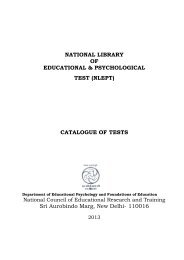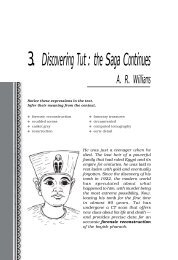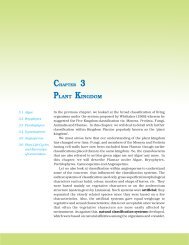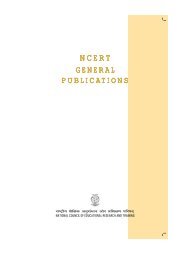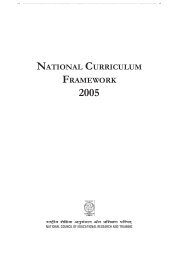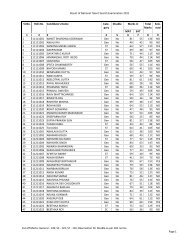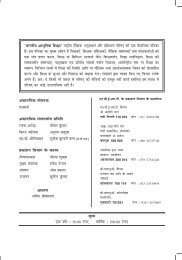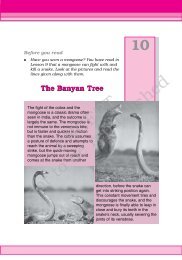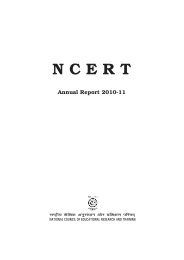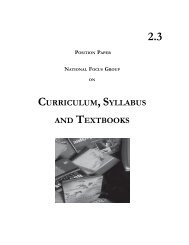indian education - National Council Of Educational Research And ...
indian education - National Council Of Educational Research And ...
indian education - National Council Of Educational Research And ...
Create successful ePaper yourself
Turn your PDF publications into a flip-book with our unique Google optimized e-Paper software.
Religion, Education and Peace 33<br />
The unusual procedure of placing<br />
practice before theory flows from features<br />
in Krishnamurti’s discourse that escape<br />
systematic analysis. Krishnamurti did<br />
not present his point of view in a clear<br />
expository manner. He had doubts about<br />
philosophy’s speculative programmes.<br />
He was an iconoclastic thinker who<br />
fashioned a discourse of his own, the<br />
chief purpose of which was to challenge<br />
both the intellectual and emotional presuppositions<br />
of his audiences. In Kafka’s<br />
moving words, his books and talks served<br />
as ‘an ice-axe to break the seas frozen<br />
inside our soul.’ For him, theory and<br />
practice were interdependent, meant to<br />
support each other: peace was a living<br />
spiritual presence, which had its own<br />
action. One might, following<br />
Abhinavagupta’s commentary on the<br />
Dhvanyaloka, describe Krishnamurti’s<br />
understanding peace as an aesthetic<br />
flavour (santarasa) that hangs over<br />
places where all life is welcomed, and<br />
whose inhabitants abjure violence, and<br />
seek to live a life of dedicated to doing<br />
the right thing.<br />
The role of culture in building identity<br />
took several of our modern religious<br />
thinkers into the past. Unlike Swami<br />
Vivekananda and Sri Aurobindo, who<br />
attempted to create an Indian<br />
renaissance through spiritual revival of<br />
Hinduism, Krishnamurti distanced<br />
himself entirely from the nationalistic<br />
spirit they had espoused and from the<br />
traditional vocabulary they used.<br />
Instead, in an entirely new departure for<br />
a religious thinker, he embraced<br />
modernity — its sceptical spirit, its<br />
emphasis on everyday life, and its focus<br />
on the individual as opposed to the<br />
group. Holding on the one hand that the<br />
process of modernisation was inevitable,<br />
he denied on the other that<br />
permissiveness, nihilism and extreme<br />
forms of relativism were certain to follow<br />
in its wake. Krishnamurti sought to<br />
embed his vision of a ‘good human being’<br />
in the practice of <strong>education</strong>.<br />
Rishi Valley School was established<br />
by a philosopher of Indian origin who was<br />
educated with some pomp and ceremony<br />
by Annie Besant and her international<br />
group of Theosophists in Europe.<br />
Intended for the great universities of<br />
Europe, Oxford, Cambridge, or Sorbonne,<br />
Krishnamurti’s academic record was<br />
dotted with failures. By the time he left<br />
Europe for America in 1922 he had<br />
forgotten his native Telugu. In 1922,<br />
having abandoned his scholastic career,<br />
he crossed the Atlantic and arrived at<br />
the Western coast of the American<br />
subcontinent, in Berkeley. He was<br />
dazzled by the place, by its sheer beauty<br />
as well as the sense of equality he<br />
perceived in the academic community.<br />
It seemed to him that the New World had<br />
created a people who transcended all<br />
‘odious distinctions’ of class, race, and<br />
gender, so endemic in the Old World. The<br />
young man’s thoughts travelling to India,<br />
he wrote, ‘Oh! For such a University of<br />
California to be transplanted to India’. If<br />
his native country had something to give<br />
to such a place of learning, it lay in the<br />
gift of being able to ‘create the proper<br />
religio-scholastic atmosphere.’<br />
Not long afterwards this visit to<br />
California, the search for a place to locate<br />
his <strong>education</strong>al institution led<br />
Krishnamurti to south India, to the little<br />
town of Madanapalle where he was born.<br />
Twenty-five kilometres from there, in a<br />
small valley carved out from the



